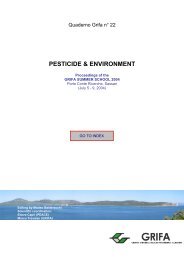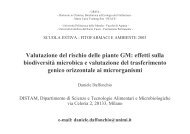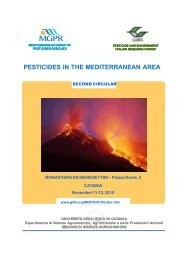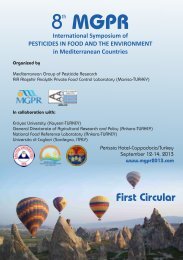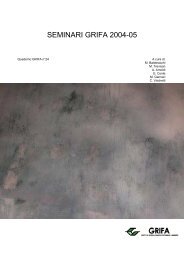International Congress BIOLOGICAL PRODUCTS - Gruppo di ...
International Congress BIOLOGICAL PRODUCTS - Gruppo di ...
International Congress BIOLOGICAL PRODUCTS - Gruppo di ...
You also want an ePaper? Increase the reach of your titles
YUMPU automatically turns print PDFs into web optimized ePapers that Google loves.
Xenorhabdus spp. and Photorhabdus spp. are carried in the intestine of the infective stages of nematodes; Steinernema<br />
spp. have a special intestinal vesicle where the bacteria are kept while Heterorhab<strong>di</strong>tis spp. have their symbionts in the<br />
lumen of the anterior part of the gut.<br />
Once the nematodes have penetrated a host, they release the bacteria symbiont in the haemolymph causing a<br />
septicaemia and the host <strong>di</strong>es. Inside the larval cadavers the bacteria growth and nematodes develop to adult stages,<br />
multiply and sexually reproduce. Although the nematodes can grow axenically (without any micro-organism) or on<br />
other bacteria, their reproduction is optimal only in presence of their natural symbiont. Thus, Xenorhabdus spp. and<br />
Photorhabdus spp. have the status of obligate symbiont because they provide essential nutrients for the correct<br />
multiplication of the nematodes (Boemare et al., 1997).<br />
The nematode-bacterium complex represents an exciting example of co-evolution that involves the interaction between<br />
the host and the nematode-bacterium complex, the relationship within the two symbiotic partners and the interaction<br />
between the bacterium and its bacteriocines. To investigate these three connections, it is necessary to study the insect<br />
defence reactions, the pathogenicity of the nematodes and the bacterium pathogenicity, symbiotic properties and<br />
lysogeny.<br />
Insects have an immune system based on phagocytosis and encapsulation of exogenous agents. The recognition of<br />
foreign bo<strong>di</strong>es is me<strong>di</strong>ated by the production of some humoral factors (Boemare et al., 1997). Entomopahtogenic<br />
nematodes are able to depress or to escape the immune defence of insect larvae. This is obtained both with nonrecognition<br />
by insect humoral factors and by escaping the phagocytosis and encapsulation. The nematodes secrete an<br />
immune-depressive factor against insect immuno-proteins <strong>di</strong>rected against the symbiotic bacteria. As been reported also<br />
that axenic nematodes produce toxin(s) able to cause paralysis and death of the host (Simoes, 1994). Symbiotic bacteria<br />
<strong>di</strong>splay also pathogenic action them-self: they produce toxins and secrete enzymatic complex (proteases, lipases and<br />
phospholipases) that help the establishment of septicaemia in the host. Thus both partners of the symbiotic complex<br />
collaborate to kill the host. It is also been reported that axenic S. glaseri or its sole symbiont X. poinarii, have no<br />
entomopathogenic action, but this was restored after re-association of both partners (Akhurst and Boemare, 1990). The<br />
observed lysogenity of the bacterial symbiont is also useful for the symbiosis relationship because it helps the<br />
symbionts to compete with closely related bacteria.<br />
Production of useful molecules<br />
Both Xenorhabdus and Photorhabdus spp. can be grown independently from they nematodes partners under standard<br />
laboratory con<strong>di</strong>tions. In vitro, bacteria secrete several extracelluar products: proteases, chitinases, lipases,<br />
phospholipases, antibacterial and antimycotic substances. Those compounds are produced also in vivo and the enzymes<br />
<strong>di</strong>gest the tissues of dead larvae in order to provide nutrients for both bacteria and nematodes. The antifungal and<br />
antibacterial products are used to preserve the cadavers from the colonisation of other microorganisms. Those active<br />
substances have also been tested for their use in biolgical control of phytopatogenic fungi (Ng and Webster, 1997).<br />
In vitro, X. nematophilus and X. bovienii produce aliphatic amides (Park and Paik, 2001) and <strong>di</strong>thiolpyrrolones tested<br />
for antineoplastic activity (Webster and Chen, 1999).<br />
Recently, strains of Photorhabdus capable to secrete exotoxins (Bowen et al., 1998), or to produce endotoxins (Ragni et<br />
al., 1997), with oral insecticidal activity, have been described. This new source of natural toxins could help both the<br />
fight against the development of insect resistance as well as novel sources of specific activities in combination with<br />
other known bio-pesticides.<br />
Target organisms<br />
Due to their poor resistance to dry con<strong>di</strong>tions, EPNs are mainly applied against soil dwelling insects. Otiorrhynchus<br />
sulcatus F. (Coleoptera, Curculionidae) is considered one of the major worldwide insect pests. The larvae feed on the<br />
root system of several plant species (mainly ornamentals and nursery stock) producing its consequent decay and very<br />
significant economic losses. A part other Curculionids such as Conorhychus men<strong>di</strong>cus, Balaninus elephas, Diaprepes<br />
abbreviatus and Cylas formicarius on ornamentals, berries, citrus, sugar beet and chestnuts, other pests are: Scarabeids:<br />
Popilia japonica, Maladera matrida, Phyllopertha horticola , Apho<strong>di</strong>us spp. on lawns, orchards, nurseries and sweet<br />
potatoes; Diptera: Sciarids, Phorids, Scatopsids, Cecidomids on mushrooms, greenhouses; Lepidoptera: Noctuids on<br />
vegetable crops. Several stu<strong>di</strong>es have been performed to find out if EPNs can be used on the aerial part of the plants<br />
against chewing and sucking insect, but, yet, without any important success.<br />
Application Technology<br />
Particular strategies must be developed in order to insure the successful delivery of the nematodes to the target site and<br />
target insect. Many parameters must be investigated to improve EPNs performance. One of these is the determination of<br />
target insect life-stage susceptibility, since <strong>di</strong>fferent life stages of <strong>di</strong>fferent species are not equally susceptible. It has<br />
been shown that pest population levels and behaviour have a great influence on nematode performance and must be<br />
considered carefully. Often, larval stages of insects such as borers are not accessible to nematodes. Selecting the most<br />
PDF creato con FinePrint pdfFactory versione <strong>di</strong>mostrativa http://www.secom.re.it/fineprint<br />
33



